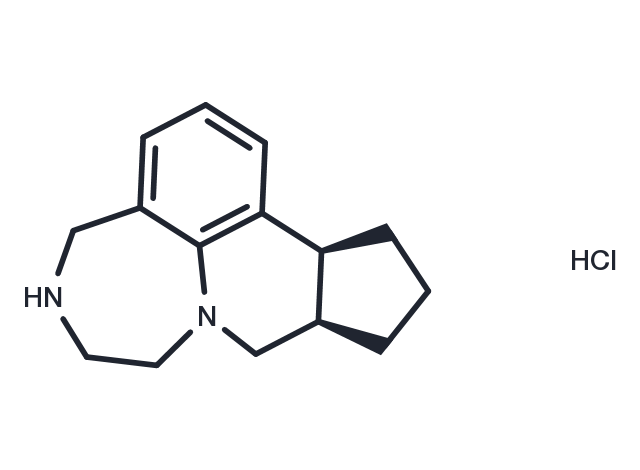Powder: -20°C for 3 years | In solvent: -80°C for 1 year


Vabicaserin hydrochloride (SCA 136) is a selective agonist of 5-hydroxytryptamine 2C (5-HT2C) receptor (EC50: 8 nM).

| Pack Size | Availability | Price/USD | Quantity |
|---|---|---|---|
| 1 mg | In stock | $ 148.00 | |
| 5 mg | In stock | $ 372.00 | |
| 10 mg | In stock | $ 556.00 | |
| 25 mg | In stock | $ 896.00 | |
| 50 mg | In stock | $ 1,220.00 | |
| 100 mg | In stock | $ 1,650.00 | |
| 500 mg | In stock | $ 3,290.00 | |
| 1 mL * 10 mM (in DMSO) | In stock | $ 397.00 |


| Description | Vabicaserin hydrochloride (SCA 136) is a selective agonist of 5-hydroxytryptamine 2C (5-HT2C) receptor (EC50: 8 nM). |
| Targets&IC50 | 5-HT2C:8 nM (EC50) |
| In vitro | In Chinese hamster ovary cell membranes, Vabicaserin displaces 125I-(2,5-dimethoxy)phenylisopropylamine binding from human 5-HT2C receptor sites (Ki: 3 nM) and is >50-fold selective over a number of serotonergic, noradrenergic, and dopaminergic receptors. The binding affinity determined for the human 5-HT2B receptor subtype using [3H]5HT is 14 nM. Vabicaserin is a potent and full agonist (EC50, 8 nM; Emax, 100%) in stimulating 5-HT2C receptor-coupled calcium mobilization and exhibits 5-HT2A receptor antagonism and 5-HT2B antagonist or partial agonist activity in transfected cells, depending on the level of receptor expression. Vabicaserin showed a lower affinity at the binding site (22 nM) of 5-HT2C antagonist labeled with [3H]methsulamide. Other binding studies have shown that Vabicaserin has an affinity for 5-HT2B and 5-HT1A receptors with Ki values of 14 and 112 nM, respectively [1]. |
| In vivo | After administering a single oral dose of [14C]Vabicaserin (50 mg/kg in mice, 5 mg/kg in rats, and 15 mg/kg in dogs), the unchanged drug accounted for less than 19%, 20%, and 35% of the total plasma radioactivity in mice, rats, and dogs, respectively, at all examined time points. The carbamoyl glucuronide (CG) comprised approximately 7-36% of plasma radioactivity in mice, 2-28% in dogs, and was absent in rat plasma following the single [14C]Vabicaserin dose, yet observed in rat plasma after multiple-dose administration of Vabicaserin at higher doses, being roughly 20 times lower than Vabicaserin based on AUC0-24 values at steady state. The plasma AUC0-24 ratios of CG to Vabicaserin were 1.5 in mice and 1.7 in dogs post-single dose. At doses used for safety assessment, these ratios at steady state were lower for mice (0.2-0.6) but slightly higher for dogs (1.8-4.0). CG was detected in dog urine at amounts comparable to the parent drug but was not found in mouse or rat urine post-single dose. Following a 5 mg/kg [14C]Vabicaserin dose in rats, 19-24% of the administered dose was recovered in bile over 24 hours, with CG representing up to 30% of biliary radioactivity. In monkeys, after a single oral 25-mg/kg dose of Vabicaserin, CG plasma concentrations surpassed those of Vabicaserin at all examined postdose intervals (2-24 h), though the CG-to-Vabicaserin ratio declined by 24 h postdose, from 17.5 at 2 h to 1.7 at 24 h, indicating that CG is a major metabolite with a 12:1 AUC0-24 ratio to Vabicaserin. |
| Synonyms | SCA 136 |
| Molecular Weight | 264.79 |
| Formula | C15H21ClN2 |
| CAS No. | 887258-94-8 |
Powder: -20°C for 3 years | In solvent: -80°C for 1 year
DMSO: 75 mg/mL (283.24 mM), Sonication is recommended.
H2O: 4 mg/mL (15.11 mM), Sonication is recommended.
You can also refer to dose conversion for different animals. More
bottom
Please see Inhibitor Handling Instructions for more frequently ask questions. Topics include: how to prepare stock solutions, how to store products, and cautions on cell-based assays & animal experiments, etc.
Vabicaserin hydrochloride 887258-94-8 GPCR/G Protein Neuroscience 5-HT Receptor SCA136 inhibit 5-hydroxytryptamine Receptor Vabicaserin Inhibitor SCA 136 Vabicaserin Hydrochloride Serotonin Receptor SCA-136 inhibitor
